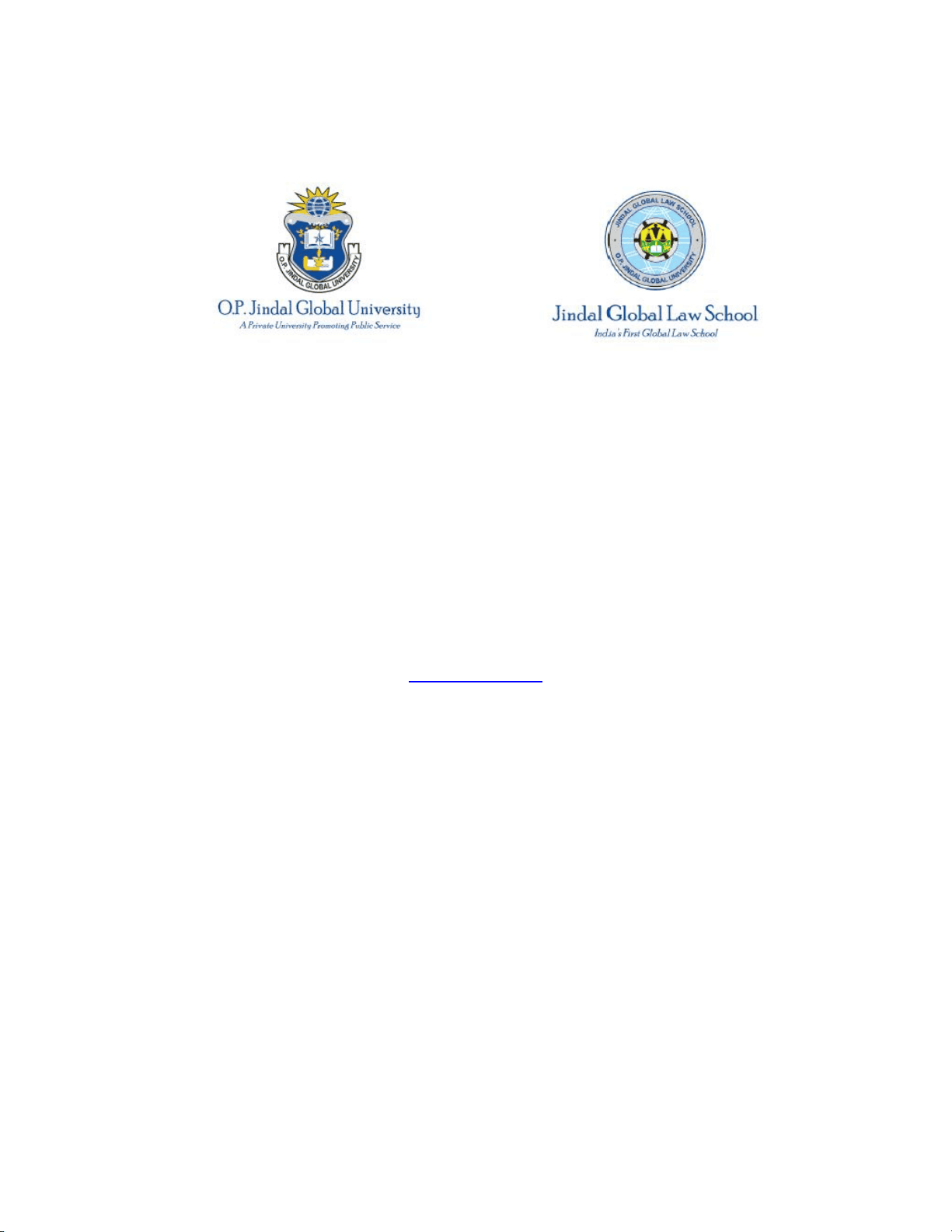


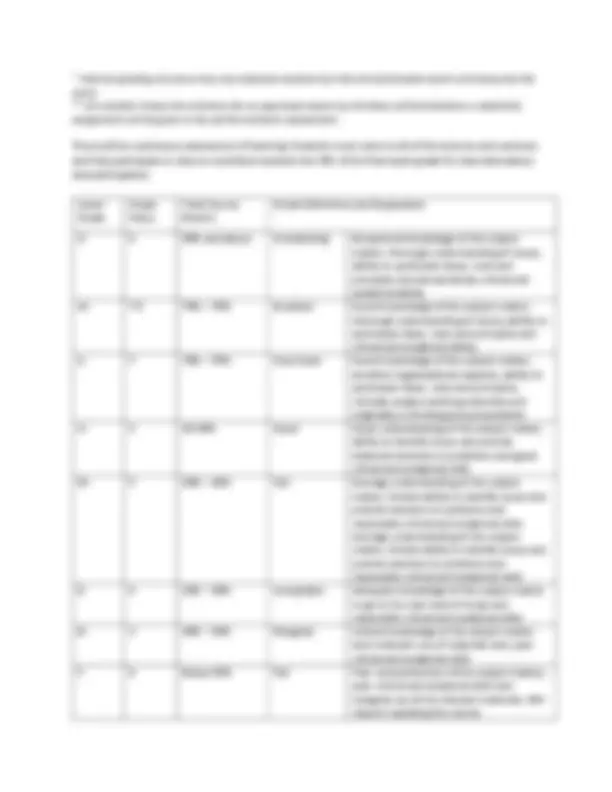
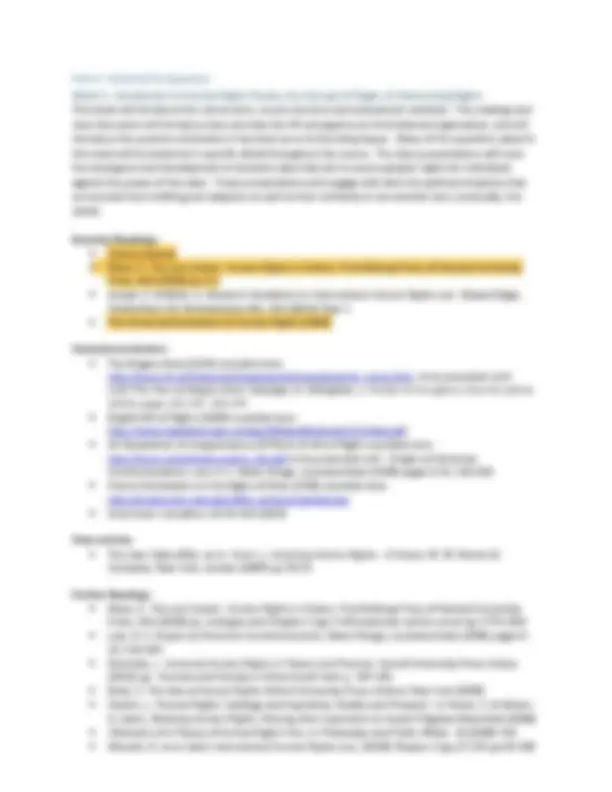
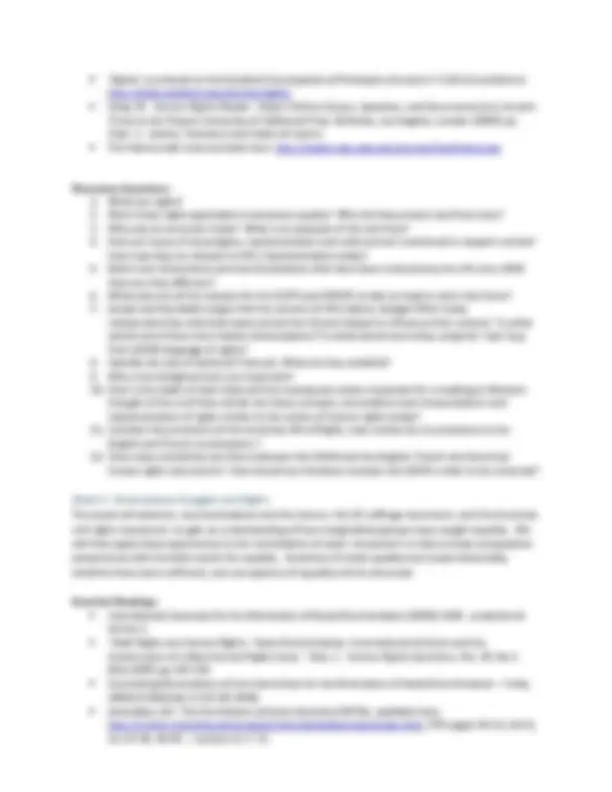
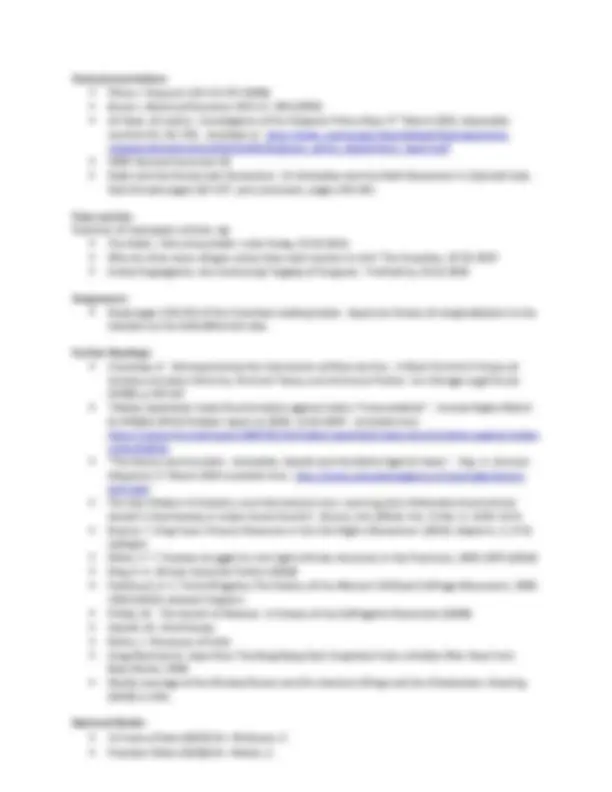


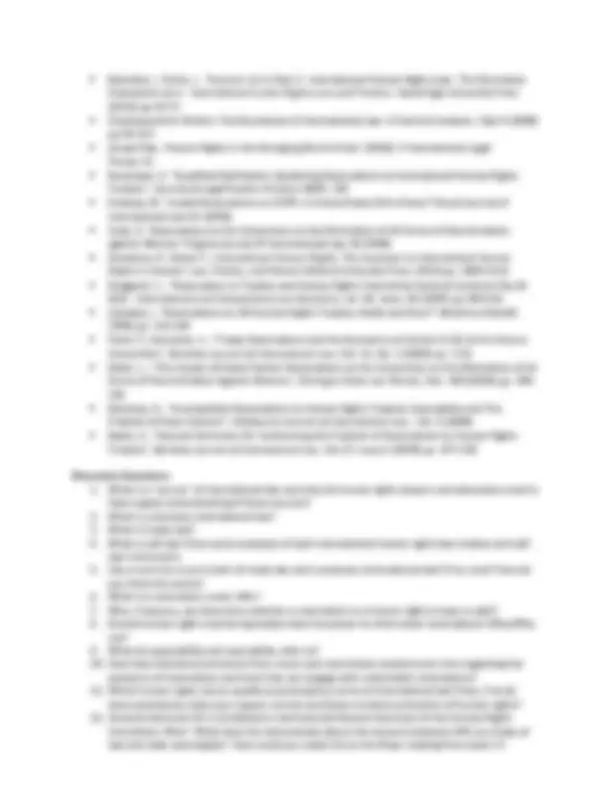
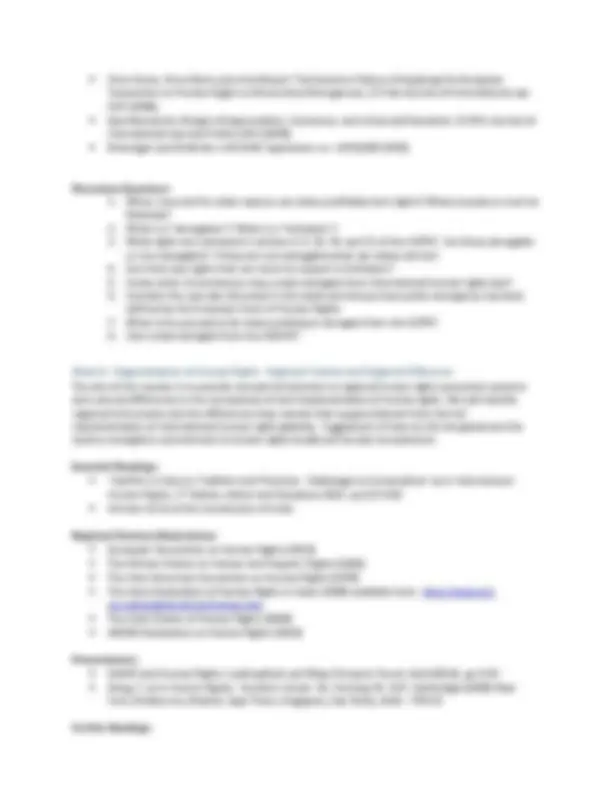

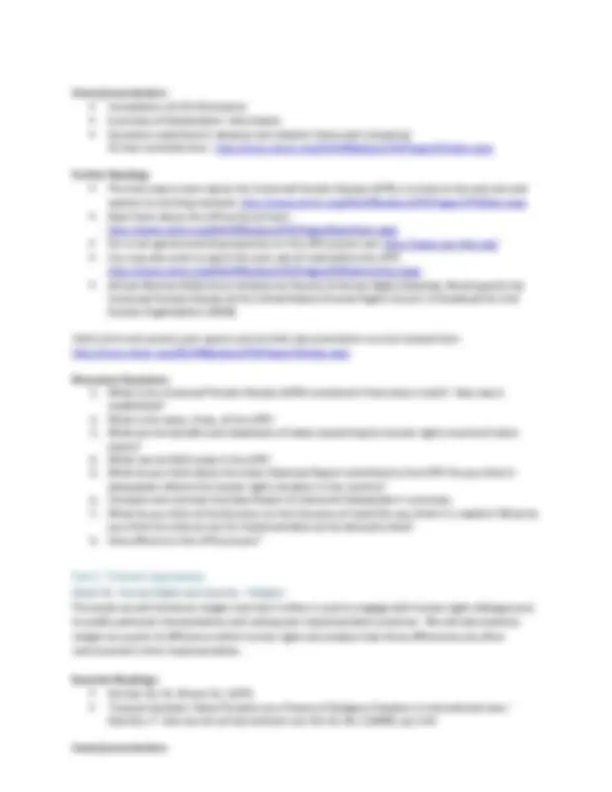
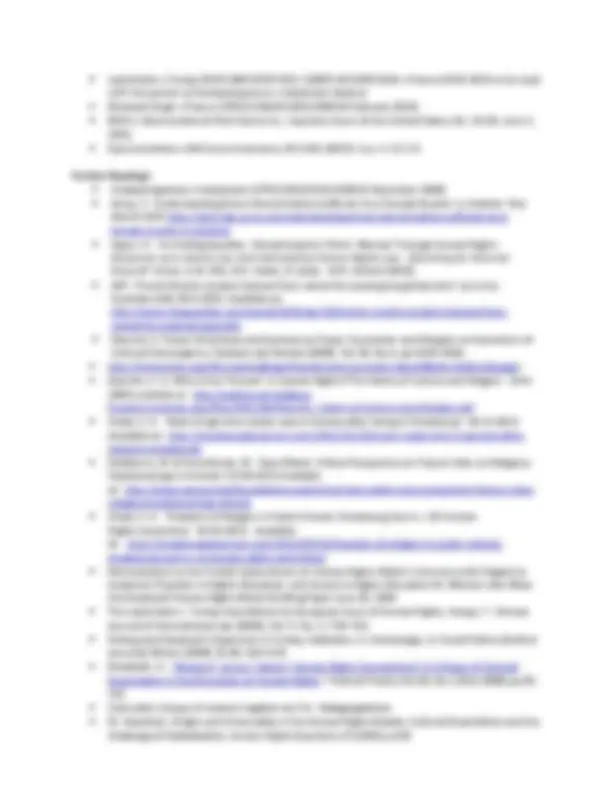
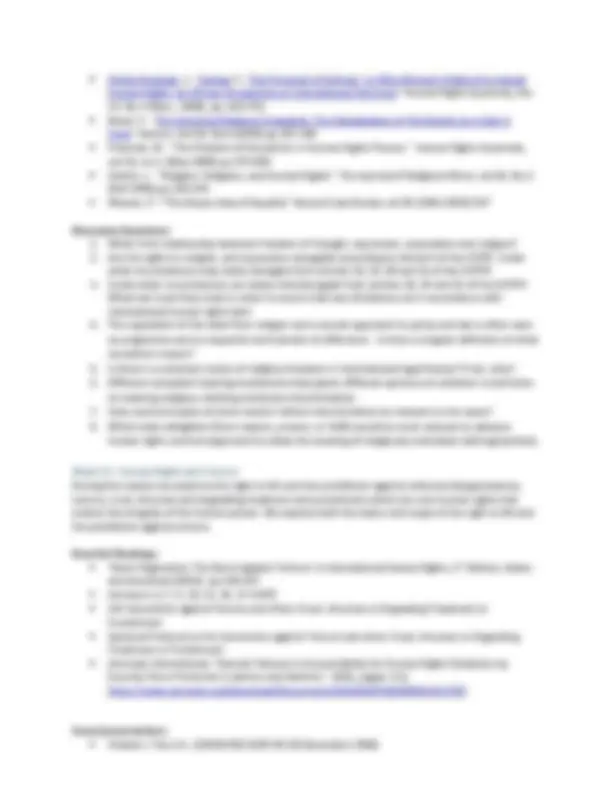
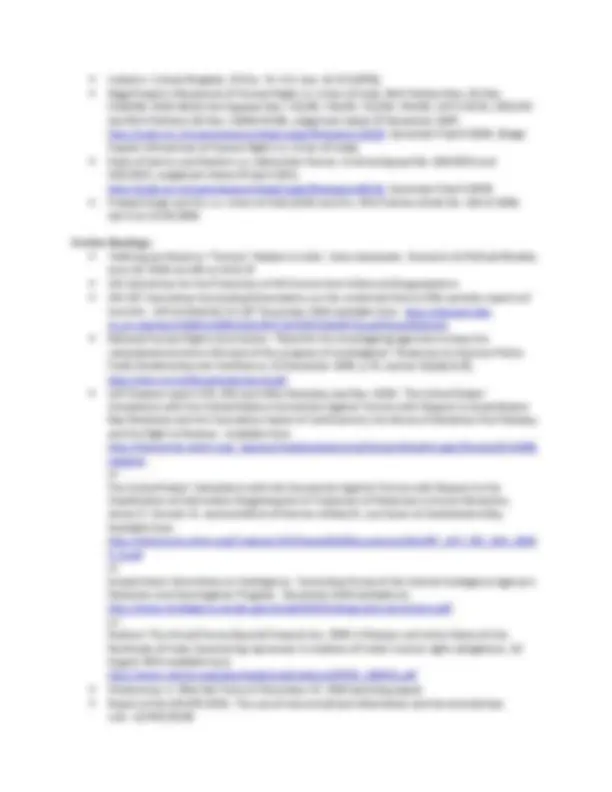




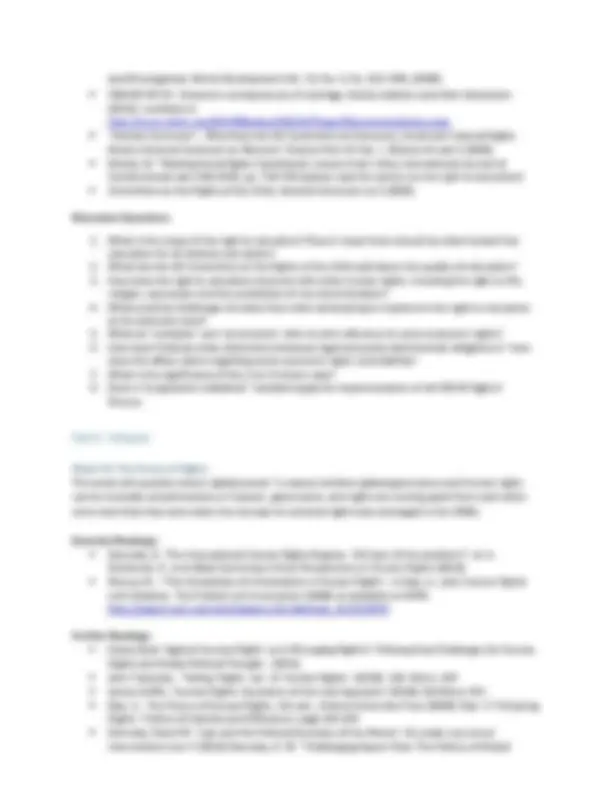



Study with the several resources on Docsity

Earn points by helping other students or get them with a premium plan


Prepare for your exams
Study with the several resources on Docsity

Earn points to download
Earn points by helping other students or get them with a premium plan
Community
Ask the community for help and clear up your study doubts
Discover the best universities in your country according to Docsity users
Free resources
Download our free guides on studying techniques, anxiety management strategies, and thesis advice from Docsity tutors
Personal Notes which can be used by law students which will be beneficial. Also have attached course manuals.
Typology: Essays (university)
1 / 29

This page cannot be seen from the preview
Don't miss anything!






















Course Instructors: Severyna Magill smagill@jgu.edu.in Office Hours: To be confirmed Semester I 2017 - 2018
Information on International Human Rights Law & Theory (JGLS) The information provided herein is by the Course Coordinator. The following information contains the official record of the details of the course. Part I Course Title: International Human Rights Law & Theory Course Code: L-CL- 0001 Course Duration: One Semester Number of Credit Units: 4 Level: BA-LLB Medium of Instruction: English Pre-requisites Public International Law Pre-cursors: Nil Equivalent courses: Nil Exclusive courses: Nil
Moeckli, D. Shah, S. Sivakumaran, S. (eds) International Human Rights Law. Oxford University Press, Oxford, New York (2013) Oette, L. Bantekas, I. International Human Rights Law. Cambridge University Press, Cambridge, New York, Melbourne, Madrid, Cape Town, Singapore, Sao Paulo, Delhi, Mexico City (2013) Human Rights Theory: Hunt, L. Inventing Human Rights: A History. W. W. Norton & Company, (2008) Hoffmann, S-L. Human Rights in the Twentieth Century: Human Rights in History. Cambridge University Press, New York (2011) Moyn, S. The Last Utopia: Human Rights in History. First Belknap Press of Harvard University Press, USA (2010) Twining, W. (ed) Human Rights: Southern Voices. Cambridge University Press, Cambridge, New York, Melbourne, Madrid, Cape Town, Singapore, Sao Paulo, Delhi (2009) Course intended learning outcomes: By the end of the course students should be able to: Demonstrate a good understanding of the theoretical foundations of human rights and the beginnings of the concept of human rights and the human rights system as we know it today. Display a good understanding of the nature and scope of international human rights law and the UN Charter and Treaty based human rights machinery. Demonstrate a good understanding of the practical application of international human rights law to specific human rights problems. Students will demonstrate in class and in the examination their ability to analyse complex human rights problems and apply relevant provisions of international human rights law to a hypothetical situation/case study and a theoretical knowledge of the underpinnings of the international human rights system, its operation and issues associated with its implementation. Teaching and Learning Activities: Reading, comparison and analysis of key international human rights law treaties, jurisprudence and academic works. Students will be assessed upon their ability to read and critically evaluate the essential readings set out in this manual. All students must attend the lectures and participate in the discussion seminar. Students must come to class ready to discuss and critically evaluate the readings. Grading of Student Achievement: Class participation (15% of total final marks); Internal assignments* (one 20% assignment and one 15% mid-term);** One written final exam (50% of total final marks).
* Internal grading structure may vary between sections but the end of semester exam will always be the same. ** If a student misses the mid-term for an approved reason by the Dean of Examinations a substitute assignment will be given in lieu of the mid-term assessment. There will be continuous assessment of learning. Students must come to all of the lectures and seminars and fully participate in class to contribute towards the 1 5 % of the final exam grade for class attendance and participation. Letter Grade Grade Value Total Course Marks ) Grade Definitions and Explanation O 8 80% and above Outstanding Exceptional knowledge of the subject matter, thorough understanding of issues; ability to synthesize ideas, rules and principles and extraordinary critical and analytical ability A+ 7.5 75% – 79% Excellent Sound knowledge of the subject matter, thorough understanding of issues; ability to synthesize ideas, rules and principles and critical and analytical ability. A 7 70% – 74% Very Good Sound knowledge of the subject matter, excellent organizational capacity, ability to synthesize ideas, rules and principles, critically analyse existing materials and originality in thinking and presentation A- 6 65 - 69% Good Good understanding of the subject matter, ability to identify issues and provide balanced solutions to problems and good critical and analytical skills B+ 5 60% – 64% Fair Average understanding of the subject matter, limited ability to identify issues and provide solutions to problems and reasonable critical and analytical skills. Average understanding of the subject matter, limited ability to identify issues and provide solutions to problems and reasonable critical and analytical skills. B 4 55% – 59% Acceptable Adequate knowledge of the subject matter to go to the next level of study and reasonable critical and analytical skills. B- 3 50% – 54% Marginal Limited knowledge of the subject matter and irrelevant use of materials and, poor critical and analytical skills. F 0 Below 50% Fail Poor comprehension of the subject matter; poor critical and analytical skills and marginal use of the relevant materials. Will require repeating the course.
Part A: Historical Perspectives Week 1: Introduction to Human Rights Theory, the Concept of Rights, & Historicising Rights. This week will introduce the course aims, course structure and assessment methods. The readings and class discussion will introduce how and why the UN emerged as an international organisation, and will introduce the question of whether it has lived up to its founding hopes. Many of the questions asked in this week will be looked at in specific detail throughout the course. The class presentations will trace the emergence and development of domestic laws that aim to secure greater rights for individuals against the power of the state. These presentations will engage with both the political situations that surrounded their drafting and adoption as well as their similarity to one another and, eventually, the UDHR. Essential Readings: Course manual Moyn, S. The Last Utopia: Human Rights in History. First Belknap Press of Harvard University Press, USA (2010) pp.1- 3 Joseph, S. McBeth, A. Research Handbook on International Human Rights Law. Edward Elgar, Cheltenham UK, Northampton MA, USA (2011) Chpt. The Universal Declaration of Human Rights (1948) Cases/presentations: The Magna Carta (1215) available here: http://www.bl.uk/treasures/magnacarta/translation/mc_trans.html to be presented with: 1215 The Year of Magna Carta. Danziger, D. Gillingham, J. Hodder & Stoughton; New Ed edition (2011) pages 141-157, 245- 274 English Bill of Rights (1689) available here: http://www.legislation.gov.uk/aep/WillandMarSess2/1/2/data.pdf US Declaration of Independence (1776) & US Bill of Rights available here: http://www.constitution.org/us_doi.pdf to be presented with: Origins of American Constitutionalism, Lutz, D. S. Baton Rouge, Louisiana State (1998) pages 5-22, 136- 149 French Declaration on the Rights of Man ( 1789 ) available here: http://avalon.law.yale.edu/18th_century/rightsof.asp Dred Scott v Sandford, 60 US 353 (1857) Class activity: The Jean Calas affair, as in: Hunt, L. Inventing Human Rights: A History W. W. Norton & Company, New York, London ( 2007 ) pp.70- 76 Further Readings: Moyn, S. The Last Utopia: Human Rights in History. First Belknap Press of Harvard University Press, USA (2010) pp. prologue and Chapter 1 (pp.1-43) especially section covering 1770- 1945 Lutz, D. S. Origins of American Constitutionalism , Baton Rouge, Louisiana State (1998) pages 5- 22, 136- 149 Donnelly, J. Universal Human Rights in Theory and Practice. Cornell University Press, Ithaca ( 2013 ) pp. ‘Humans and Society in Hindu South Asia’ p. 147 - 156 Beitz, C. The Idea of Human Rights Oxford University Press, Oxford, New York (2009) Henkin, L. ‘Human Rights: Ideology and Aspiration, Reality and Prospect,’ in Power, S. & Allison, G. (eds.), Realizing Human Rights: Moving from Inspiration to Impact Palgrave Macmillan (2006) ‘Elements of a Theory of Human Rights’ Sen, A. Philosophy and Public Affairs 32 (2004) 315 Moeckli, D. et al. (eds.) International Human Rights Law , (2010) Chapter 1 (pp.17-27) pp.49- 100
Cases/presentations: Plessy v Ferguson 163 US 537 (1896) Brown v Board of Education 349 U.S. 294 (1955) US Dept. of Justice - Investigation of the Ferguson Police Dept. 4th^ March 2015, (especially sections D1, D3, D5). Available at: http://www. justice.gov/sites/default/files/opa/press- releases/attachments/2015/03/04/ferguson_police_department_report.pdf CERD General Comment 29 Dalits and the Democratic Revolution - Dr Ambedkar and the Dalit Movement In Colonial India. Gail Omvedt pages 167- 177 , and conclusion, pages 324- 341 Class activity: Selection of newspaper articles, eg: The Dalits - Still untouchable. India Today, 03.02. Why do cities close refuges unless they want women to die? The Guardian, 22.01. School Segregation, the Continuing Tragedy of Ferguson. ProPublica, 19.12. Assignment: Read pages 139- 143 of the Crenshaw reading below. Apply her theory of marginalization to the handout on the DeGraffenreid case. Further Readings: Crenshaw, K. Demarginalising the Intersection of Race and Sex: A Black Feminist Critique of Antidiscrimination Doctrine, Feminist Theory and Antiracist Politics. Uni Chicago Legal Forum (1989) p.139- 167 ‘Hidden Apartheid: Caste Discrimination against India’s “Untouchables”’. Human Rights Watch & CHR&GJ (NYU) Shadow report to CERD. 12.02.2007. Available here: https://www.hrw.org/report/2007/02/12/hidden-apartheid/caste-discrimination-against-indias- untouchables “The Doctor and the Saint: Ambedkar, Gandhi and the Battle Against Caste.”. Roy, A. Caravan Magazine 1 st^ March 2014 available here: http://www.caravanmagazine.in/reportage/doctor- and-saint The Self, Modern Civilization, and International Law: Learning from Mohandas Karamchand Gandhi’s Hind Swaraj or Indian Home Rule B.S. Chimni, EJIL (2012), Vol. 23 No. 4, 1159– 1173 Branch, T. King Years: Historic Moments in the Civil Rights Movement. (2013) chapter1, 2, 17 & epilogue Miller, P. T. Postwar struggle for civil rights African American in San Francisco, 1945-1975 (2010) King, K. A. African American Politics (2010) Pankhurst, E. S. The Suffragette; The History of the Women's Militant Suffrage Movement, 1905- 1910 (1911) selected chapters Philips, M. The Ascent of Woman: A History of the Suffragette Movement (2004) Gandhi, M. Hind Swaraj Nehru, J. Discovery of India Greg Marinovich, Joao Silva. The Bang Bang Club: Snapshots from a Hidden War. New York: Basic Books, 2000 Media coverage of the Michael Brown and Eric Gardner killings and the Charlestown shooting (2015) in USA. Optional Media: 12 Years a Slave (2013) Dir. McQueen, S. Freedom Riders (2010) Dir. Nelson, S.
Bang Bang Club (movie) (2010) Suffragettes the story of the women who waged the war for social and economic equality. New Jersey Kultur (2008) Amistad (1997) Dir. Spielburg, S. Eyes on the Prize (1986) Exec Producer Hampton, H. Discussion Questions:
Shaw, M. International Law (CUP) Cambridge, UK. – pp.224-226 & 654-685 for the 7th^ edition (2014); pp 902 - 925 for the 6th^ edition (2008). “Confronting Racial Discrimination: A CERD Perspective,” Thornberry, P., Human Rights Law Review , vol. 5, Issue. 2 (2005) pp. 239-269. Cases/presentations : Swaran Singh v. State (2008) 8 SCC 435. Law Commission of India, Report 267, Hate Speech, March 2017, pp.15-25 & 32-36 & 37-50. CERD General Recommendation 32, 75th^ Session: The Meaning and Scope of Special Measures in the International Convention on the Elimination of All Forms Racial Discrimination (2009) available at: http://www.ohchr.org/EN/HRBodies/CERD/Pages/CERDIndex.aspx CERD General Recommendation 35, 83rd^ Session: Combating Racist Hate Speech (2013) available at : http://www.refworld.org/docid/53f457db4.html TBB-Turkish Union in Berlin v Germany, CERD Communication No. 48/2010, Doc No. CERD-C- 82 - D- 48 - 2010 and the dissenting opinion by Mr. Carlos Manuel Vazquez. Further Readings: Pravasi Bhalai Sangathan vs. Union of India, AIR 2014 SC 1591 Mahali Dawas & Yousef Shava v Denmark, CERD Communication No. 46/2009, Doc No. CERD-C- 80 - D- 46 - 2009 CERD General Recommendation 31, 65th^ Session: On the Prevention of Racial Discrimination in the Administration and Functioning of the Criminal Justice System (2005) available at: http://www.ohchr.org/EN/HRBodies/CERD/Pages/CERDIndex.aspx Optional Protocol to the Convention on the Elimination of Discrimination against Women available here: http://www.ohchr.org/EN/ProfessionalInterest/Pages/OPCEDAW.aspx Stephen Hagan v. Australia , CERD Communication No.26/2002, available at: http://www.ohchr.org/EN/HRBodies/CERD/Pages/CERDIndex.aspx Koh, Harold. Why Do Nations Obey International Law? Yale Law Journal 106 (1997): 2599. Boyle, A. & Chinkin, C. The Making of International Law (2007) Discussion Questions:
Week 5: Sources, Declarations and Reservations. This week we examine how we identify international human rights law. International human rights law is a branch of public international law – as such its sources are those set out in Article 38(1) of the Statute of the International Court of Justice (ICJ). We examine the sources of international human rights law: treaties, customary international law, jus cogens and “soft law,” and what reservations and derogations are. We will pay particular attention to the conflict between the aims of IHRL to guarantee all individuals across the world the same set of rights with the state’s ability to exercise its sovereign rights to file declarations and reservations. We will briefly examine the declarations and reservations filed against the ICCPR and CEDAW to engage with both their form and breadth. We will also examine case law over several decades to engage with the development of IHRL principles and its implementation. Essential Readings: Statute of the ICJ, Art. Vienna Convention on the Law of Treaties (1969), articles 1, 2(a), 19-23; 26, 31, 46 and 53, 56 available at: https://treaties.un.org/doc/Publication/UNTS/Volume%201155/volume- 1155 - I- 18232 - English.pdf UN Human Rights Committee, General Comment 24 (1994) Greenwood, C. ‘Sources of International Law: An Introduction’ (2008) unpublished LSE notes, pages 1-5. Baratta, R., “Should Invalid Reservations to Human Rights Treaties be Disregarded?”, European Journal of International Law , vol. 11, Issue 2 (2000) pp.413- 425 Cases/Presentations: 1951 I.C.J 15, Reservations to the Convention of the Prevention and Punishment of the Crime of Genocide, Advisory Opinion of 28 May 1951 (Summary), available at http://www.icj- cij.org/docket/index.php?sum=276&code=ppcg&p1=3&p2=4&case=12&k=90&p3= Belilos v. Switzerland (1988) 132 ECHR, available at http://hudoc.echr.coe.int/sites/eng/pages/search.aspx?i=001-57434#{"itemid":["001- 5 7434"]} UN Human Rights Committee, General Comment, no.31: The Nature of the General Legal Obligation Imposed on States Parties to the Covenant. Adopted 29th^ March 2004 UN Committee on Economic, Social and Cultural Rights, General Comment no.3: The Nature of States Parties’ Obligations. Adopted 14th^ December 1990 Key Human Rights Treaties: ( please note that you are not expected to read all of these treaties for this week’s class. However, you must familiarize yourself with these treaties over the course of the next 15 weeks) International Covenant on Civil and Political Rights (ICCPR) International Covenant on Economic, Social and Cultural Rights (ICESCR) UN Convention on the Rights of the Child (CRC) UN Convention on the Elimination of all Forms of Discrimination against Women (CEDAW) Convention on the Elimination of all forms of Racial Discrimination (CERD) Convention on the Rights of Persons with Disabilities (CRPD) Convention on the Rights of Migrant Workers (CRMW) International Convention for the Protection of All Persons from Enforced Disappearance (CPED) Further Readings: Goodman, R., “Human Rights Treaties, Invalid Reservations, and State Consent”, The American Journal of International Law , vol.96 (2002) pp.531- 560
Week 6: Equality and Non-Discrimination & Domestic Implementation of IHRL This week will examine how the concepts of equality and non-discrimination have evolved since the UN Charter and UDHR to move beyond formal equality to now push towards a more transformative and participative model. The week will identify cases that highlight the historical shortfalls in equality law’s interpretation and application and how state obligations have evolved as a corrective action against formal equality. We will also briefly consider the effectiveness of having international treaties to secure universal domestic implementation. Essential Readings: Fredman, S. ‘Substantive Equality Revisited’ Int J Const Law (2016) 14 (3): 712- 738 Megret, F. Chpt. 5 ‘Nature of Obligations’ as in International Human Rights Law , eds. Moeckli et al OUP, Oxford (2014) pp. 101 - 105 especially, optional: 96 - 119 Cases: A.T. v Hungary A/60/38 (part 1 Annex 3) Communication 2/2003, CEDAW Committee, decision 26 - Jan- 2005 Case "Relating To Certain Aspects Of The Laws On The Use Of Languages In Education In Belgium" V. Belgium (Merits) 1 EHRR 252 (1968) D.H. & Othrs. Czech Republic ECHR Grand Chamber 2007 Velasquez Rodriguez v Honduras IACtHR Series C, No.4 29-July- 1988 Class exercise: Excerpts of Osman v UK (2000) 29 EHRR 245 & information of the Stephen Lawrence murder and subsequent London Metropolitan Police’s Macpherson inquiry. Further readings: Osman v UK (2000) 29 EHRR 245 Information on the murder of Stephen Lawrence murder in London, UK, (see chpt.1) and the subsequent MacPherson Report, chapters 6 & 8, available at: https://www.gov.uk/government/uploads/system/uploads/attachment_data/file/277111/4262. pdf Fredman, S. Discrimination Law. 2nd^ ed. Oxford, UK. OUP (2010) chpt.1 , especially pp.8- 33 Moeckli, D. Chpt. 8 ‘Equality and Non-Discrimination’ as in International Human Rights Law , eds Moeckli et al OUP, Oxford (2014) pp.157- 173 Gillot v France, HRC Communication No. 932/2000 Un Doc. A/57/40 at 270 (2002) Milanovic, M., 2009. Norm conflict in international law: whither human rights? Duke Journal of Comparative & International Law. 20(1), 69- 131 Oona A. Hathaway, “Do Human Rights Treaties Make a Difference?” Yale Law Journal 111 (2002) Discussion Questions:
Shaw, M. N. Chpt. 7” ‘The Regional Protection of International Human Rights’ as in International Law. 7th^ edition Cambridge University Press, Cambridge (2014) pp.248- 284 William J. Jones, “Universalizing Human Rights The ASEAN Way,” Journal of Social Sciences 3, no.3 (2014): 72-89. Basic Income: A Transformative Policy for India (G. Standing, S. Davala, R. Jhabvala and S.Kapoor Mehta (London and New Delhi, Bloomsbury Academic, 2015). Details A Precariat Charter: From Denizens to Citizens (London and New York, Bloomsbury Academic,
Cases/presentations: Compilation of UN information Summary of Stakeholders’ information Questions submitted in advance and whether these were answered. All docs available here: http://www.ohchr.org/EN/HRBodies/UPR/Pages/INIndex.aspx Further Readings The best way to learn about the Universal Periodic Review (UPR) is to look at the web site and explore its working methods: http://www.ohchr.org/EN/HRBodies/UPR/Pages/UPRMain.aspx Basic Facts about the UPR as found here: http://www.ohchr.org/EN/HRBodies/UPR/Pages/BasicFacts.aspx For a non-governmental perspective on the UPR process see: http://www.upr-info.org/ You may also wish to watch the web cast of India before the UPR: http://www.ohchr.org/EN/HRBodies/UPR/Pages/INWebArchives.aspx African Women Millennium Initiative on Poverty & Human Rights (Zambia), Working with the Universal Periodic Review of the United Nations Human Rights Council: A Handbook for Civil Society Organizations (2010) India’s first and second cycle reports and all other documentation are also located here: http://www.ohchr.org/EN/HRBodies/UPR/Pages/INIndex.aspx Discussion Questions